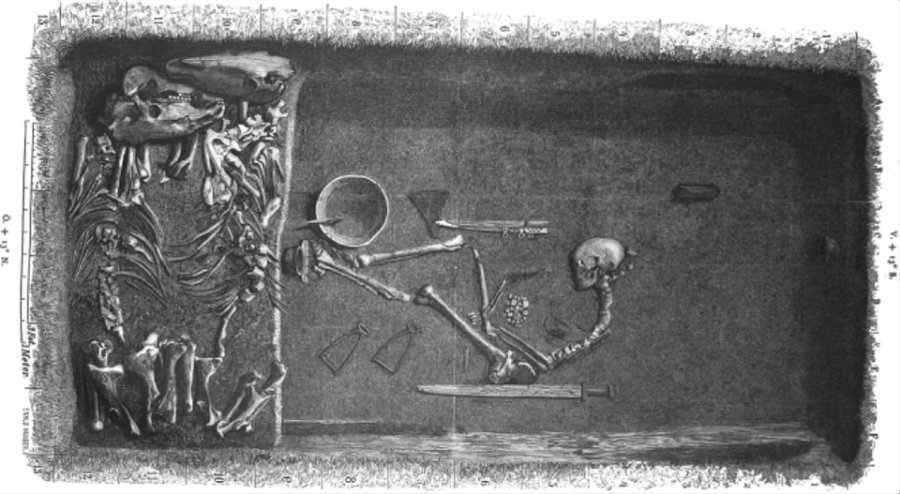A team of researchers just confirmed that the remains of an old Viking warrior found more than a century ago in Sweden actually belonged to a woman, not a man. The discovery was made at the end of the 19th century, and ever since, historians and archeologists assumed the body belonged to a strong, male, Viking warrior.
The body was found –buried along arms and horses—and excavated by Swedish archaeologist Hjalmar Stolpe in the Viking Town of Birka, Sweden.

Now, osteology and DNA tests revealed that the Swedish warrior had always been a female, and researchers believe she was likely a powerful military leader. The findings were published online Friday in the American Journal of Physical Anthropology.
Viking female warrior was likely an important military leader
Charlotte Hedenstierna-Jonson, an archeologist at Uppsala University, Sweden, who led the investigation, said the woman was somewhere over the age of 30 and “fairly tall too,” at 170 centimeters.
“Aside from the complete warrior equipment buried with her – a sword, an axe, a spear, armor-piercing arrows, a battle knife, and two horses – she had a board game in her lap, or more of a war-planning game used to try out battle tactics and strategies, which indicates she was a powerful military leader,” she told The Local Sweden. “She’s most likely planned, led and taken part in battles.”
The warrior was buried in one of the most iconic graves of the Viking Age during the mid-10th century. Hedenstierna-Jonson describes it as “the world’s ultimate warrior Viking grave.” Due to the number of warrior equipment that was found with the remains, it was just assumed –and never proven—that the remains belonged to a man.

Isotope analyses performed on the Viking warrior confirmed an itinerant lifestyle, which falls in line with the martial society that dominated 8th to 10th century in northern Europe.
The unidentified Viking warrior was likely to “stay” a man forever if it hadn’t been for Anna Kjellström, who several years ago realized the remains did not appear to be those of a man.
Researcher noticed Viking warrior had typically feminine features
Kjellström, an osteologist at the Stockholm University, brought out the remains a couple of years ago for another research project and noticed that something was odd about the so-called male Viking warrior.
She noticed the cheekbones were finer and thinner than that of a man, and when she took a closer look at the hip bones, she found they appeared to be typically feminine. She ended up carrying an osteological test on the remains and found the results supported her thesis. Now, finally, DNA tests confirmed her beliefs, that she was a woman.
“The morphology of some skeletal traits strongly suggests that she was a woman, but this has been the type specimen for a Viking warrior for over a century why we needed to confirm the sex in any way we could,” said Kjellström, who also worked on the new study, according to Popular Archaeology.
That led the researchers to turn to genetics tests, to retrieve a molecular sex identification based on X and Y chromosomes. That sort of test can be conducive, according to Maja Krezwinska, who also worked on the research.
Krezwinska noted using ancient DNA for gender identification is useful when working with children, for example, but it can also help resolve “controversial cases such as this one.” Krezwinska was able to confirm the morphological sex identification with the presence of an X chromosome and the lack of the Y one.
Experts meet findings with skepticism
The authors wrote in their study that the image of the male warrior in a patriarchal society “was reinforced by research traditions and contemporary preconceptions,” so the biological sex of the individual was generally taken for granted.
The study also states that while some Viking women buried with weapons are already known, a female warrior of such importance had never been determined and Viking scholars “have been reluctant to acknowledge the agency of women with weapons.” Hedensternia-Jonson says the Viking woman was likely a warrior herself.
“You can’t reach such a high [military] position without having warrior experience, so it’s reasonable to believe that she took part in battles,” she told The Local Sweden. “It was probably quite unusual, but in this case, it probably had more to do with her role in society and the family she was from, and that carrying more importance than her gender.”
Hedensternia-Jonson noted the finding is fantastic, but she doubts it will completely up-end historians’ view of the Viking patriarchal society, which was reportedly only constituted of male warriors.
She added that since they found the first evidence that suggested the warrior was a woman, the researchers have been met with skepticism by other experts; some of whom have questioned whether the remains analyzed came from that particular grave.
Source: The Local Sweden
